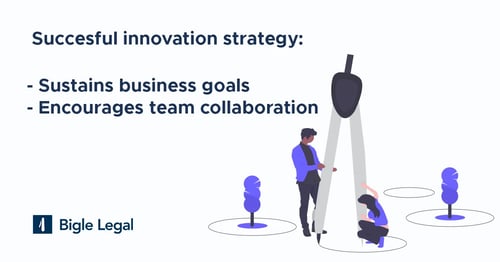How to effectively introduce Legal Technology in your law firm?
It’s no secret that the legal industry is rapidly transforming and today, law firms and legal departments from all over the world are feeling the pressure to respond.
Perhaps it’s no wonder; clients expect better and more efficient customer service and law firms feel the need to stand out from the crowd.
In many cases, they are doing things like giving their payment models a make-over, or adopting innovative legal technology tools - but often there’s no plan.
However, when it comes to making bigger steps, it turns out that many legal professionals are not sure where to start and how to initiate the process.
To really come out ahead in the transforming legal industry, it’s essential that firms and in-house lawyers develop a well-thought-out innovation strategy as well as effective legal team management.
This is a type of roadmap that outlines how they’ll achieve their legal innovation goals.
But why exactly is it so important to have an innovation strategy? And how should it be introduced in your legal department or law firm? Let’s explore!
First of all, what is an innovation strategy?
Innovation is great, but means nothing (or simply turns into a novelty) when it doesn’t contribute to a larger plan.
That’s why an innovation strategy is so essential: it’s an organization’s commitment to a number of policies and actions developed to achieve clear, innovative objectives and goals.
For law firms, it can define why and how they’ll embrace legal design. It ensures every team member is on board with the same mission. And, ultimately, this mission should involve increasing the value of the firm’s current offerings and align with business strategy.
Why do you need an innovation strategy?
Law firms and legal departments are notorious for being traditional. However, in recent years, their dated business models and technologies haven’t done much for them.
According to a 2018 joint report by Thomson Reuters Legal Executive Institute and the Center for the Study of the Legal Profession at Georgetown Law, the flat demand for legal services, declining productivity levels and the rise of alternative legal service providers has made a big dent on profits at traditional firms.
The average lawyer billed 156 hours less in 2018 than they did in 2007, states the report – and this costs firms about $74,000 per lawyer each year.
It’s a pretty shocking number. However those that break away from traditional business models - and create more value through strategic innovation - are more prone to last.
The report explains further:
“Over the last few years,” it reads, “there has been mounting evidence that law firms that proactively address the needs of their clients – e.g., by implementing alternative staffing strategies, pursuing flexible pricing models, adopting work process changes, making better use of innovative technologies, and the like – can achieve significant success.”
How do you introduce innovation without wasting money?
The very first step to a strong innovation strategy in any law firm or legal department is to make sure you have a business strategy in place, with clear financial goals, performance indicators and critical success factors.
Once this is defined, your innovation strategy must be designed to sustain your business strategy - it should not be seen as something separate.
Nevertheless, connecting the two can be difficult.
According to the same 2017 PwC report mentioned above:
"54 percent of executives have a hard time aligning innovation with business strategy, and 65 percent of companies investing 15 percent or more in innovation are essentially “flying blind.”
To avoid spending recklessly, it’s important for the firm’s business side and innovative team to work side-by-side from the start in order for innovation to pay off in the long run.
Use the following checklist to introduce purposeful and strategic innovation at your law firm. It will help you grow and service you customers’ needs, without feeling like you’re introducing innovation for innovation’s sake.
The innovation strategy checklist
1. Determine your objectives`
Your law firm or legal department knows it needs to innovate. But to what end?
The first step to developing an innovation strategy is to decide on what the purpose of your innovation is:
- Is it to save lawyers time?
- Is it to unplug the legal bottle-neck in your organization?
- Is it to speed up delivery for clients?
- Is it to streamline client communication?
Maybe it’s all four.
Boasting a clear-cut sense of why your firm or department is innovating encourages everyone to keep their creative ideas focused. And with so many legal innovation and legal technology tools on the market these days, having an innovation strategy helps law firms to decide on which ones they should actually leverage - and which they’re better off taking a pass on.
2. Understand what your customers want
Putting client needs first is the cornerstone to legal innovation. So when deciding on a legal strategy, lawyers better have a good understanding of what their clients are after, that is what legal design is all about.
If you’re working in a law firm, this can be done through paying close attention to the current legal market and evaluating what attracts clients to alternative legal services.
On the other hand, if you’re working in a legal department, you can simply ask the leadership department where the pain points are and how they would like to improve things.
In fact, according to PwC’s 2017 Innovation Benchmark Report, 35 percent of companies state customers are their biggest innovation partners.
It’s simple, really: if clients aren’t satisfied, they’ll find legal council elsewhere - and if you’re legal department isn’t solving problems efficiently, it’s holding back company growth.
An innovation strategy can help put you on the right path.
3. Communicate the strategy to the whole team
Your innovation strategy might be exciting, but it won’t come to life unless the entire team is on board. It’s up to the partners to clearly communicate the new strategy to their team, and share how the changes will help the firm or legal department - and ultimately its lawyers - to thrive.
It’s also important to provide team members with enough training on new technologies or processes put in place to ensure employee morale doesn’t falter - something that could easily happen to team members accustomed to working at more traditional firms.
4. Feel free to adjust
Embracing innovation requires agility. So if metrics show a certain process or legal technology tool isn’t working the way you had hoped, its ok to abandon them. Setting expectations, and being honest when things don’t work out, is the only way for your firm to grow - and ultimately rise past competition.
Work-life balance is also an essential aspect that will help your legal team boost their productivity and enhance on their legal operations.
Are you ready for the future?
All in all, firms and legal departments that prepare themselves for the legal industry innovation future have every chance of doing well. However those who don’t manage to uproot their traditional ways of working may well fall short - and could even find themselves obsolete.
So, which do you choose?
 By
By




.webp?width=500&height=197&name=Starting%20legal%20innovation%20(1).webp)


